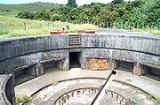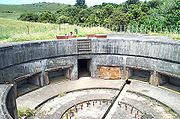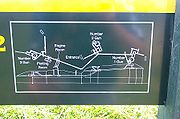
Stony Batter
Encyclopedia

Waiheke Island
Waiheke Island is an island in the Hauraki Gulf of New Zealand, located about from Auckland.The island is the second-largest in the Hauraki Gulf after Great Barrier Island. It is the most populated, with nearly 8,000 permanent residents plus another estimated 3,400 who have second or holiday homes...
, Auckland
Auckland
The Auckland metropolitan area , in the North Island of New Zealand, is the largest and most populous urban area in the country with residents, percent of the country's population. Auckland also has the largest Polynesian population of any city in the world...
, New Zealand
New Zealand
New Zealand is an island country in the south-western Pacific Ocean comprising two main landmasses and numerous smaller islands. The country is situated some east of Australia across the Tasman Sea, and roughly south of the Pacific island nations of New Caledonia, Fiji, and Tonga...
. It is sited within a 50 acre (200,000 m²) scenic reserve of the same name, owned by the New Zealand Department of Conservation
New Zealand Department of Conservation
The Department of Conservation , commonly known by its acronym, "DOC", is the state sector organisation which deals with the conservation of New Zealand’s natural and historic heritage...
(DOC). The park serves double duty as a historical (Category 1 Historic Place) and nature reserve, containing unusual rock formations, three significant bush blocks and three concrete gun emplacements with an extensive tunnel system, reputed to be the largest in New Zealand.
An extensive vineyard on the surrounding privately-owned farm is also named after the installation. For almost two decades, the farm's owner had a dispute with Auckland City over public access to the reserve, finally resolved in 2002 by the Privy Council
Judicial Committee of the Privy Council
The Judicial Committee of the Privy Council is one of the highest courts in the United Kingdom. Established by the Judicial Committee Act 1833 to hear appeals formerly heard by the King in Council The Judicial Committee of the Privy Council (JCPC) is one of the highest courts in the United...
agreeing with the Council's case providing public access. If one examines the lead up to the access dispute, one finds that the land owner was suffering huge losses through theft of his farm stock, some of which were barbecued on site, and others were trucked off the farm to be butchered elsewhere on the island. The thefts were of such a magnitude, tens of thousands of dollar value per annum, that the viability of the stock fattening part of the landowner's business was being jeopardised. Mr John Spencer, the landowner at the time, took one of the few options open to him and blocked access to his property.
History
Stony Batter was of part of a counter-bombardment battery system progressively being installed in the Hauraki GulfHauraki Gulf
The Hauraki Gulf is a coastal feature of the North Island of New Zealand. It has a total area of 4000 km², and lies between the Auckland Region, the Hauraki Plains, the Coromandel Peninsula and Great Barrier Island...
from the 1930s. Composed of various gun batteries, such as at Whangaparaoa, Motutapu Island
Motutapu Island
Motutapu Island is a island in the Hauraki Gulf to the northeast of the city of Auckland, New Zealand. The island is part of the Hauraki Gulf Maritime Park....
and at Stony Batter, as well as having observation posts such at Rangitoto Island (command post) and Tiritiri Matangi Island
Tiritiri Matangi Island
Tiritiri Matangi Island lies in the Hauraki Gulf of New Zealand, east of the Whangaparaoa Peninsula in the North Island and north east of Auckland. The island is an open nature reserve managed under the supervision of the Department of Conservation and is noted for its bird life, including kiwi...
, it was supposed to engage enemy naval forces entering the inner gulf. Ranges would have been too far beyond the line of sight (over 30 km, thus the need for a complex set of observation points and communication lines), as well as at least initially beyond the range of most enemy ships' ability to retaliate.
While approved in 1939, construction was delayed for cost reasons until German raiders were sighted in New Zealand waters during 1940-1941, as well as the war entry of Japan in late 1941, suddenly turned it into a high-priority project. In 1942, the site on Waiheke was chosen, but it took until early 1943 before the Public Works Department
New Zealand Ministry of Works
The New Zealand Ministry of Works, formerly the Department of Public Works and sometimes referred to as the Public Works Department or PWD, was founded in 1876 and disestablished and privatised in 1988...
was finally tasked with construction after other contractors declined the job. Delays were caused by the remote location, which at first had no road access, and also by the fact that the project was kept in strict secrecy, requiring with a large degree of self-sufficiency during the construction period, complete with its own living facilities and machine shops. The new battery was generally referred to only as A2, to conceal its location.
The tunnels and underground chambers were quarried by hand, with formwork
Formwork
Formwork is the term given to either temporary or permanent molds into which concrete or similar materials are poured. In the context of concrete construction, the falsework supports the shuttering moulds.-Formwork and concrete form types:...
for the walls and ceilings, then filled with concrete
Concrete
Concrete is a composite construction material, composed of cement and other cementitious materials such as fly ash and slag cement, aggregate , water and chemical admixtures.The word concrete comes from the Latin word...
(reinforcing steel
Rebar
A rebar , also known as reinforcing steel, reinforcement steel, rerod, or a deformed bar, is a common steel bar, and is commonly used as a tensioning device in reinforced concrete and reinforced masonry structures holding the concrete in compression...
was not used due to shortages). Aggregate
Construction Aggregate
Construction aggregate, or simply "aggregate", is a broad category of coarse particulate material used in construction, including sand, gravel, crushed stone, slag, recycled concrete and geosynthetic aggregates. Aggregates are the most mined material in the world...
was obtained from the prominent rocky outcrops, giving Stony Batter its name. The tunnels and chambers where designed based on plans of the Tawa Flat railway tunnels
Tawa Flat deviation
The Tawa Flat deviation is a double-track section of the North Island Main Trunk Railway just north of Wellington, New Zealand. It includes two tunnels, Tawa No. 1 and Tawa No. 2 , separated by the Ngauranga Gorge. No. 2 tunnel passes under Newlands and comes out at Glenside, on the way to Tawa...
project. The work on the installations, sans guns, was completed behind schedule in 1944, and had by then ballooned from initial estimates of £140,000 to £327,966, excluding the costs of the guns. Construction of the battery was, however, considered a major feat of engineering, carried out under particularly difficult circumstances. As the tides of war turned, only two guns were installed, one in 1944, and one in 1948. The third gun was cancelled before shipment. Never fired except for testing and training purposes, the guns were dismantled and sold for scrap in 1961.
The battery is now in the hands of a preservation society, which keeps it open for the public under a concession from DOC. The preservation society is currently trying to source an appropriate artillery piece to restore at least one gunpit to a similar state as it would have appeared in late WWII.
Characteristics

Next to the gun pits, which can be accessed at any time, the site also contains around a kilometre of tunnels, most of which are accessible by guided tour. These connected the gun pits with each other and with their ammunition stores, a plotting room, an engine room providing electricity, as well as with storerooms and barracks (located aboveground).
Temporary closure
In June 2006, the Stony Batter site was closed by the Department of ConservationNew Zealand Department of Conservation
The Department of Conservation , commonly known by its acronym, "DOC", is the state sector organisation which deals with the conservation of New Zealand’s natural and historic heritage...
, which administers the reserve, after a series of complaints of verbal and one of physical abuse was laid against one of the preservation society's founder members, Sue Pawley, by a number of visitors. The reserve was reopened to the public on15 August 2007, partly due to public pressure after 3,000 signatures had been collected on the island in favour of the proposal.
The Society's website
The Stony Batter Preservation and Restoration Society does not currently have a website. For a number of years there was a comprehensive website with hundreds of photographs and detailed descriptions of every aspect of access to the reserve and the restoration work being undertaken there. After committee disputes and disagreeable politics within the society, the website was closed down. It took eighteen months before a skeleton replacement site appeared, and another two years before a few pictures were added to it. For the entire duration of the replacement website's existence, it showed 'Under Construction' pages, and not surprisingly, it too has now disappeared. If the society's committee history is any indication, internal dissension and refusal to approve hosting fees will be at least partly to blame.Management of Stony Batter into the future
Over the years the NZ Department of Conservation has repeatedly threatened to either close the site or take over management, seemingly reluctant to peremptorily deal with the problems associated with the dysfunctional concession operator. DoC staff to their credit have made a considerable number of improvements, including upgraded signage and interpretation, but their efforts have always met with criticism from a vocal minority of society members. Unfortunately the status quo with the concessionaire remains. In its favour, the society has made some progress toward restoring the site to something resembling its heyday in the mid-to-late 1940s, such as the partial reinstallation of one of the Ruston diesel generators, the likes of which would never have eventuated had it been left to DoC's more purely-administrative, rather than restorative, role. The future is an open book, yet to be written, but we can be confident that the concrete of the gun emplacements is thick enough to outlive the present committee, and many iterations of DoC which will certainly follow.See also
- Coastal fortifications of New ZealandCoastal fortifications of New ZealandCoastal fortifications were constructed in New Zealand in two main waves. The first wave occurred around 1885 and was a response to fears of an attack by Russia. The second wave occurred during World War II and was due to fears of invasion by the Japanese....
- North HeadNorth Head, New ZealandNorth Head is a volcanic cone forming a headland within North Shore City, New Zealand, in the suburb of Devonport at the east end of the Waitemata Harbour ....
, New ZealandNew ZealandNew Zealand is an island country in the south-western Pacific Ocean comprising two main landmasses and numerous smaller islands. The country is situated some east of Australia across the Tasman Sea, and roughly south of the Pacific island nations of New Caledonia, Fiji, and Tonga...
, administrative centre of the coastal defense - Wrights Hill FortressWrights Hill FortressWrights Hill Fortress is a counter bombardment coastal artillery battery in the Karori suburb of Wellington, New Zealand. It was built between 1942 and 1947 and is predominantly underground, with numerous tunnels linking the war shelters, gun emplacements, magazines, plotting rooms and engine room...
, a similar installation in Wellington
- North Head
External links
- Stony Batter Preservation & Restoration Society (official society website)
- Stony Batter - Waiheke Island at Recreation Access New Zealand

